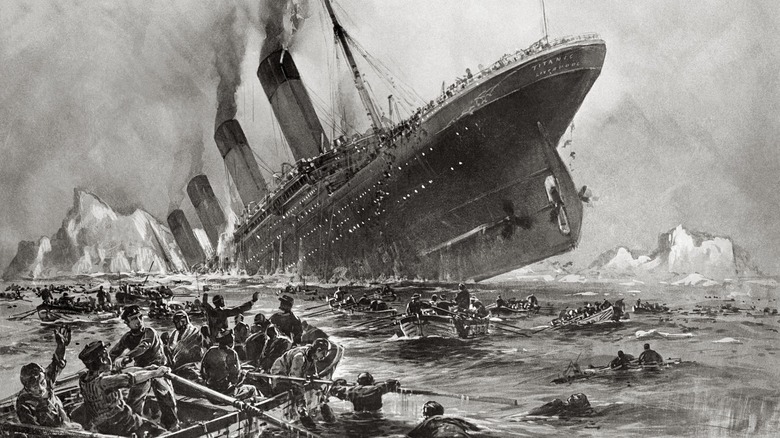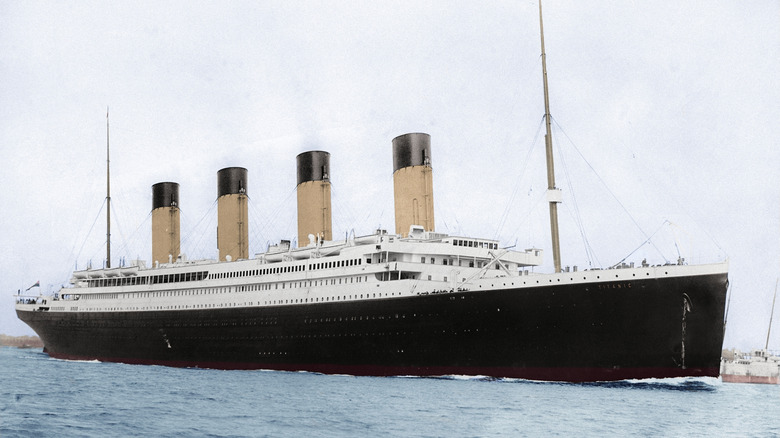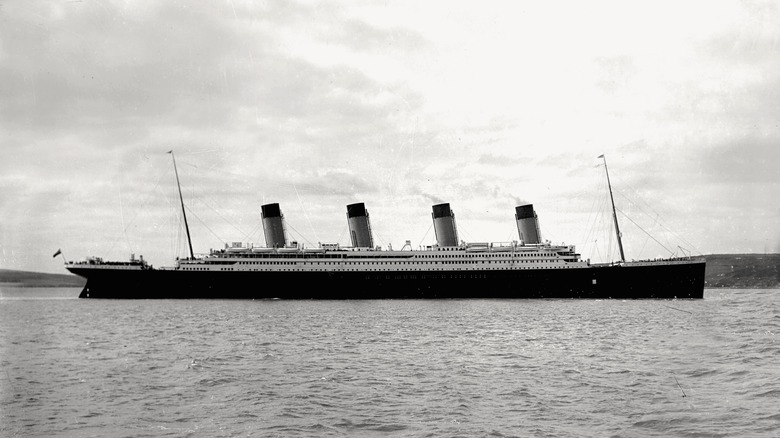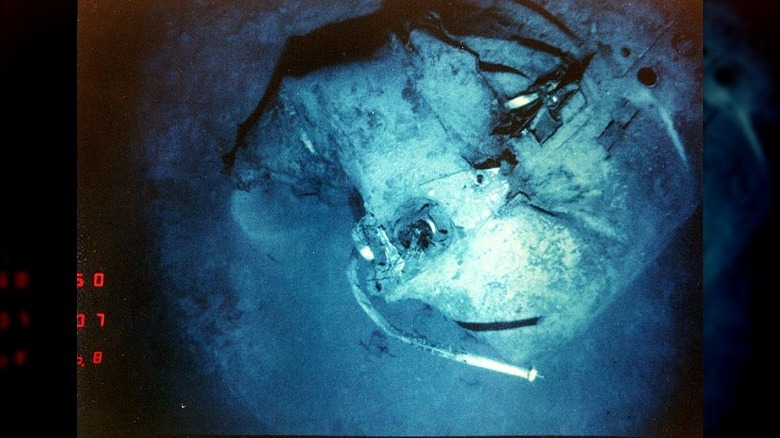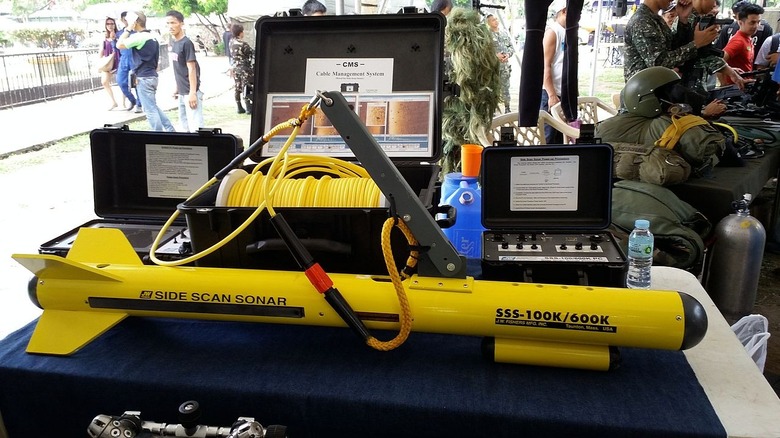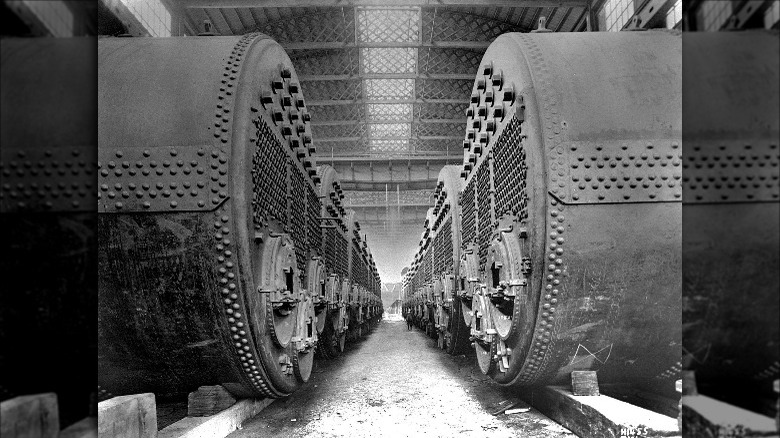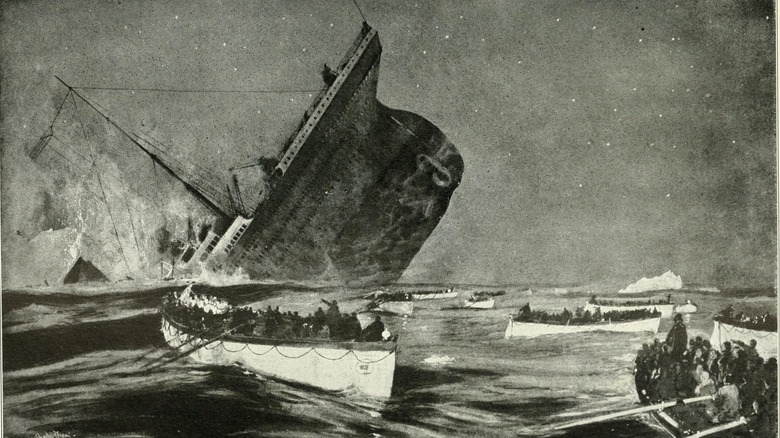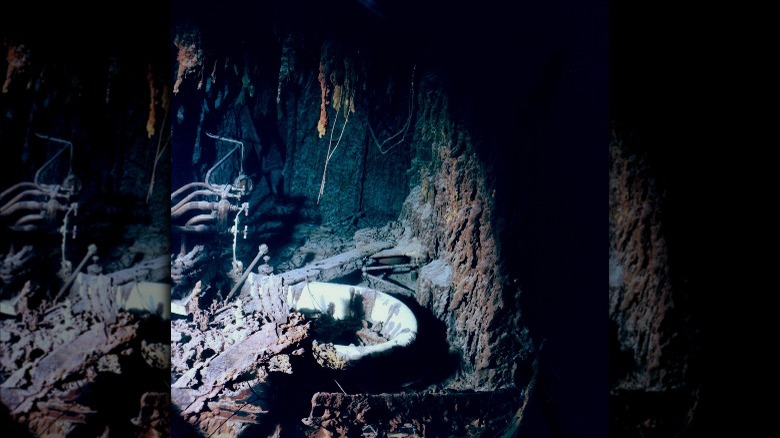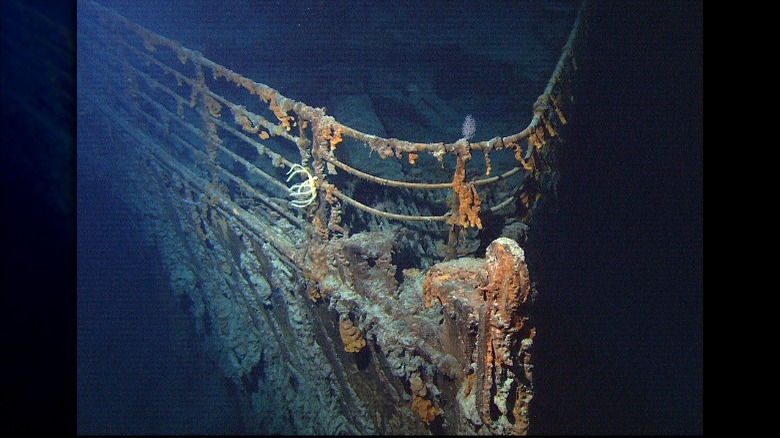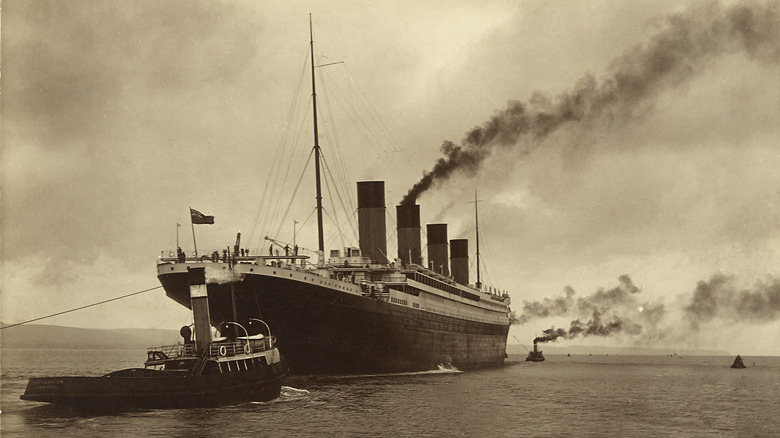How They Really Discovered The Wreckage Of The Titanic
Much has been made about the life of the Titanic, the then state-of-the-art ocean liner that hit an iceberg and sank in the early hours of April 15, 1912. According to History, an estimated 1,500 people died that night. For those who weren't directly connected to the disaster or found themselves compelled by the massive tragedy, it may have seemed as if the tragic story ended there.
Of course, it didn't. There were survivors, for one, not to mention the writers, historians, and curiosity seekers who became fascinated by the Titanic's story in the years after the sinking. And then there was the matter of the ship. Yes, the Titanic had sunk beneath the waves that night, but everyone knew that it hadn't disappeared. Somewhere, in the deadly cold waters of the northern Atlantic Ocean, probably half buried in mud on the seafloor, was what remained of the once luxurious ocean liner.
As the years went on, a series of researchers and occasionally less scientific explorers sought to locate the Titanic and all of the goods that it carried. Some were likely motivated by the idea of salvaging the ship and its contents, while others were driven by the need to connect with history and the many lives lost in the sinking. It all finally came to a head in 1985. Here's how they really, finally discovered the wreckage of the Titanic.
The Titanic was missing for over 70 years
If you're not already well versed in the tragedy of the Titanic sinking, then you may need a bit of background information. According to History, the ship struck an iceberg in the north Atlantic around 11:30 pm on April 14, 1912. Though it initially seemed to be only a graze along the side of the hull, it soon became clear that the liner was taking on water. Passengers were evacuated, but the process was slow and poorly organized, meaning that many were left behind when the ship finally sank around 2:20 am on April 15th. Over 1,500 people died that night, out of an estimated 2,240 people on board. The ship itself reportedly broke into two pieces and sank to the bottom of the ocean.
Given all of the eyewitnesses and the eventual ships that arrived to rescue the survivors, you'd think that it would be relatively easy for later investigators to find the wreckage. But it wasn't quite so simple, History reports. The ship kept drifting after transmitting its last known location, leaving people with a large search area that covered hundreds of miles. Finding a single ocean liner — or its two pieces, as some reports indicated — on the seafloor about 12,600 feet below the surface (via Time) meant that anyone trying to recover the Titanic would have to put in some serious time, effort, and willpower to find her.
Some of the early proposals to raise to Titanic were odd
Almost immediately after the Titanic sank, it seemed as if people were prepared to pull the wreck (and its array of goods) up out of the Atlantic. Things didn't really change all that much as the decades wore on. People still wanted to figure out where the ship was and, once it had been located, raise it. But some of those proposals were notably odd, as Mental Floss reports. One British company suggested filling the ship with Vaseline contained in bags and allowing the hardened petroleum jelly to float the wreck to the surface. Others thought modified Ping Pong balls would work.
In the more immediate aftermath of the wreck, Denver architect Charles Smith came up with an idea that basically centered on using a submarine and a bunch of magnets, according to "Iceberg, Right Ahead!" Plenty also seemed interested in balloon-based ideas, while others suggested a mixture of liquid nitrogen. However, given that no one had found the wreck yet, it all remained highly theoretical.
A Texas oilman got close to finding the wreckage
Though other researchers got more traction later in the search for the Titanic, Texas oil tycoon Jack Grimm may well have been the most colorful of the lot. According to the New York Times, not only did Grimm make a seemingly honest effort to find the location of the wreck, but he also dabbled in the searches for Bigfoot, the Loch Ness Monster, and the remains of Noah's Ark. Though Grimm himself would maintain otherwise, few people were convinced by the evidence he produced from his various expeditions, including a photograph that supposedly showed the Titanic's anchor.
To Grimm's credit, he brought a considerable amount of money to the search for the Titanic. And the scientists he hired were able to collect valuable data about that area of the north Atlantic using what was then some pretty advanced tech. Still, as Bob Ballard noted in his own book, "The Discovery of the Titanic," Grimm's inability to ultimately produce the wreck itself diminished his standing.
That certainly wasn't helped by Grimm's odder moments, such as when he introduced Titan, a new teammate, to the crew searching for the Titanic. But Titan was a monkey who would somehow point out the location of the wreck on the map. According to The Vintage News, the scientists flatly told him that it was either Titan or the research team. Grimm reportedly balked at first but was eventually persuaded to leave the simian back on shore.
Robert Ballard is credited for the re-discovery of the Titanic
Though plenty of people had plenty of ideas (both sensible and strange) about how to find and salvage the Titanic over the years, the shipwreck went undiscovered for many decades after its 1912 sinking. Ultimately, professor and oceanographer Bob Ballard was the one who, along with his team, was able to claim credit for finally locating the Titanic in 1985, per Britannica. But that wasn't without some struggle of his own, as Ballard had already attempted to find the wreck in the '70s and had come up with nothing.
Still, if anyone was going to find the Titanic, it would likely have been someone like Ballard. By the 1980s, according to ThoughtCo, he was already a serious scientist and explorer who had served in the Navy and, more specifically, had worked with the Woods Hole Oceanographic Research Institution in the organization's Deep Submergence Group. As if that weren't enough, he also earned two doctorates in marine geology and geophysics and designed a submersible, the Alvin, which was made to take humans far beneath the surface of the ocean.
Prior to his 1985 achievement, Ballard had already taken part in expeditions that uncovered deep sea vents and proved that life there could survive without sunlight. Yet, in his words, he was always focused on finding the Titanic. "That was a Mt. Everest in my world," he said.
The U.S. Navy funded Ballard's expedition for a top secret reason
The harsh reality of many scientific expeditions is the need for money. Sure, explorers and researchers need to have passion, education, and dedication to their cause, but it's often all for naught if their wallets are empty. A ship, after all, needs fuel, a crew, equipment, and any manner of other supplies ready before it can even leave port. But, for Bob Ballard, his 1985 trip to find the Titanic had a somewhat surprising and, for a long time, very secretive funder.
Blame it on the Cold War. According to CNN, Ballard was actually approached by the U.S. military to find the wrecks of two submarines, the Thresher and the Scorpion, which happened to also be in the north Atlantic. After finding the two nuclear vessels, he was essentially free to search for the hopefully nearby Titanic. Given that he found the older ship, it was a convenient cover during the tense years remaining between the U.S. and the Soviet Union.
During the expedition, National Geographic reports that Ballard was actually put back on duty as a Navy officer, though of course he wasn't able to disclose that at the time. It also only left him with 12 days to look for the Titanic, given all of the time needed to locate and document the submarines.
Technology helped Ballard's team find the Titanic
Ultimately, there was no real way that someone was going to find the wreck of a single ocean liner in the frigid waters of the north Atlantic without some serious assistance from technology. Or, as Ballard and his team were betting, a lot of assistance from technology.
According to the Woods Hole Oceanographic Institution, the group — which was actually co-led by Ballard and Jean Louis Michel of the French National Institute of Oceanography — first began its search with sonar. A system built by Michel was deployed to "mow the lawn," meaning that a ship was tasked with making its way across the search area in regular strips, towing side scan sonar equipment in order to get a glimpse of the ocean floor. After 31 days, they still hadn't found the Titanic, but had managed to eliminate a whopping 75% of the search area.
Ballard's team (accompanied by three of Michel's scientists) then used the Acoustically Navigated Geological Underwater Survey (ANGUS) to start looking for the ship's debris field. Per History, they also deployed an unmanned submersible with a camera, known as the Argo. If the Titanic really had broken into two pieces, it would have left a considerable swathe of bits and pieces scattered across the seafloor. Looking for evidence of the debris field would hopefully be easier than searching for the ship itself. And, given that this is exactly how the team found the wreckage, it clearly worked.
They first found the ship's boiler
Ballard's tactic was to search for the ship's debris field, cast about as its two halves sunk to the ocean floor. The very first thing that they found, according to History, was one of the ship's distinctive boilers lying on the seabed. The crew initially celebrated the momentous find, but then paused when they realized that it was nearly 2:20 in the morning, the same time the Titanic had sunk beneath the waves on April 15, 1912.
Eventually, Ballard and his team also found some of the ship's hull plates. More and more detritus came into view, including dinnerware and furniture that would have been used by the passengers and crew. Using the Argo to follow the trail of debris across the ocean floor, they eventually came across the bow of the long-lost Titanic. They quickly began taking images of the wreck, which included a relatively intact bow and a far more damaged stern section lying about 400 meters (or 1,300 feet) away.
The discovery proved a major theory about the wreck
Going off eyewitness reports, many had guessed that the Titanic had split in two. According to Encyclopedia Titanica, that wasn't necessarily a consensus, however. A minority of eyewitnesses, including officers of the Titanic's White Star Line, claimed that the ship had sunk intact. However, it's possible that they were biased, given that there were other White Star ships and the idea that any more could split into two parts could have damaged the company's credibility and ticket sales.
Many more testimonies didn't specify exactly in what shape the Titanic had been when it finally sank beneath the water after a couple of hours of sinking. Given the confusing evacuation, the dark night (the Titanic sank with only a sliver of moon in the sky, according to The Speed of Creativity), and the trauma of the accident, it's no wonder that those details were confused.
The two-piece theory was proven by Ballard's team's discovery of the wreck, as the bow and stern were clearly separated by over 1,000 feet. But how did such a large ship break into two pieces that night in 1912? According to Scientific American, it's all about physics. As the bow took on water, the stern began to lift, putting pressure on the ship. Specifically, pressure on its riveted hull sections caused the liner to unevenly break apart into two large sections.
Later expeditions have shown that the Titanic is disintegrating
Unsurprisingly, the Titanic wasn't in fantastic shape when Ballard found it. The ship had, after all, split into two pieces and scattered debris across the seabed. What's more, it's been sitting there, accumulating mud and rust for over seven decades. But, it was still undeniably the Titanic, given that Ballard's team was able to identify features like the location of the ship's famed "grand staircase" (via History).
Since that 1985 rediscovery, multiple expeditions have been made out to the location of the wreckage. And, as the years have gone on and more and more people have interacted with the Titanic, the deterioration of the sunken liner has continued apace. According to National Geographic, the environment has not been kind to the ship, leading to buckling roofs and the collapse of the famous crow's nest, where lookout Frederick Fleet first saw the iceberg that took down the liner.
In 2019, ABC News reported that the first manned dive in 14 years found even more damage, with the famous captain's bathtub having already fallen through steadily weakening floors. What's more, bacteria that consume iron have produced "rusticles," which, though now a visual hallmark of the wreck, is still striking evidence of the Titanic's steady deterioration (via NOAA). Little can really be done to halt the decay, though efforts to scan the wreck will hopefully produce 3D models that can remain long after what's left of the Titanic has finally collapsed into the mud.
Ballard is vocally opposed to looting the Titanic
Though some euphemistically call it "salvage," Bob Ballard has stronger words for the prospect of people snatching up bits and pieces of the Titanic: looting. And, given that the wreck is the final resting place of an estimated 1,500 people, according to Britannica, many have concluded that salvage operations are little more than grave robbing. Ballard has certainly spoken of the site with the sort of reverence reserved for gravesites, once saying "It is a quiet and peaceful place – and a fitting place for the remains of this greatest of sea tragedies to rest. Forever may it remain that way" (via The New York Times).
According to CNN, Ballard says that he certainly understands the fascination that so many people have with the Titanic. The dream of finding and documenting the wreck is one that's been following him since he was young, after all. But, in his words, "It's being loved to death by visitors more than mother nature is attacking it."
It's true that salvagers have been picking apart the wreck, says NBC News. Some have obtained legitimate licenses to do so, while others have surely been working illegally (it's hard to have enforcement officers at the ready in international waters). And it's very possible that, while some artifacts may have fallen deeper into the wreck as the ship deteriorates, some pieces of the Titanic's history have been plucked up by those salvagers and are sitting in someone's private collection.
The wreckage of the Titanic kind of has protected status
For those who are especially worried about the prospect of people picking over the remains of the Titanic, the ship now enjoys some measure of protection. According to NPR, in early 2020, the United States and the United Kingdom reached a joint agreement on managing the site of the sunken ocean liner.
Technically, a treaty debuted in 2003 but it was never officially ratified after Canada and France seemed to give it the cold shoulder. The U.S. was dragging its feet as well, but changed its mind and accepted the treaty in late 2019. Preexisting UNESCO established some rules, but the new treaty is set to expand upon some of the basic guidelines set out in 2012 by the United Nations.
However, enforcing those treaties and rules can often seem straightforward in a board room somewhere, but get tricky when you're out on the open ocean. And, given how the Titanic can be vulnerable to even legitimate visitors and the forces of time and nature, it remains to be seen just how effective that protected status may be.
Bob Ballad has continued his underwater exploration
What do you do after you accomplish one of your greatest dreams? For Bob Ballard, that was no reason to stop exploring. Though he acknowledges that he'll probably always be remembered as one of the co-discoverers of the Titanic wreck, that's no excuse to rest on one's laurels.
Not that having such a reputation is necessarily a bad thing. "In many ways it's sort of freed me up to dream other dreams. So I feel emancipated in many ways," Ballard told CNN. In the years since his 1985 achievement, he estimated that he's found about 100 shipwrecks in all, a pretty considerable number for a single person (especially when you factor in the amount of funding pitches he's likely had to do, too).
In 2019, Ballard even put in one of the more extensive efforts to find evidence of Amelia Earhart's fate. Earhart, a renowned aviator, disappeared during a round-the-world flight attempt in 1937. According to the New York Times, some believed that she may have survived a plane crash and made it to Nikumaroro atoll, a remote island in the Republic of Kiribati. Ballard and his team weren't able to find evidence of her plane around the atoll, but it was an illuminating trip nonetheless, using advanced sonar technology to scour the nearby ocean floor. And, as Ballard reminded everyone on the team, it's worth remembering that he had missed the Titanic by a mere 500 feet in a pre-1985 expedition.
